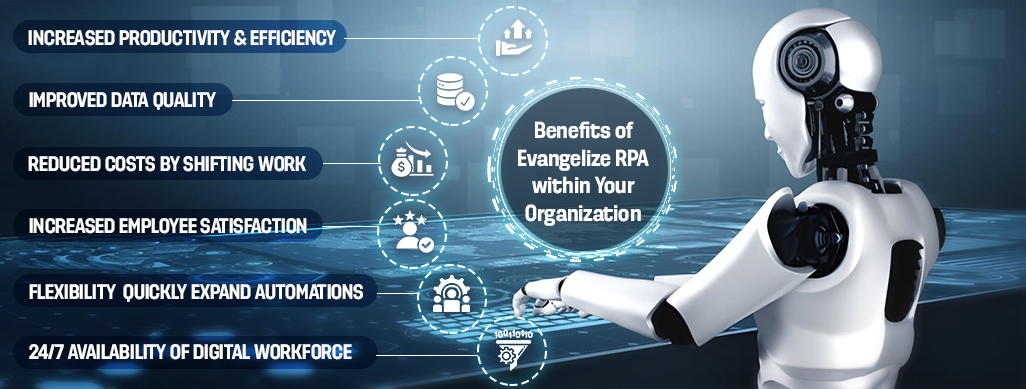
We use cookies to ensure that we give you the best experience on our website.
By using this site, you agree to our use of cookies. Find out more.
This blog aims to provide guidance on how to successfully evangelize RPA within your organization. It will begin by explaining what evangelizing RPA means and exploring key Robotic process automation benefits.

Robotic process automation (RPA) has the potential to greatly improve efficiency and productivity within organizations. However, one big challenge is evangelizing RPA to key stakeholders so they understand its strategic benefits. This blog aims to provide guidance on how to successfully evangelize RPA within your organization. It will begin by explaining what evangelizing RPA means and exploring key Robotic process automation benefits. Some advantages of RPA include increased productivity, improved data quality, reduced costs and higher employee satisfaction. The blog then outlines important steps to evangelize RPA, like identifying stakeholders, demonstrating value through pilots and communicating benefits clearly. Following this advice can help organizations embrace RPA and realize significant gains.
Evangelizing RPA refers to driving institutional awareness and adoption of robotic process automation on an enterprise-wide scale. As RPA enables streamlining of routine tasks, its full potential can only be realized when implemented across departmental functions. However, achieving organizational buy-in requires effective change management involving communication of benefits and proof of value.
Evangelizing RPA involves creating internal advocacy by engaging stakeholders, demonstrating measurable results of pilots, training users and gaining senior leadership sponsorship for funding ongoing initiatives. The goal is to promote an understanding of how automation helps address bottlenecks, so it becomes a regularly leveraged solution.
Here are the main benefits of evangelizing RPA within your organization:

One of the major Robotic Process Automation benefits is increased productivity and efficiency through automating repetitive tasks. RPA bots are able to perform high-volume repetitive workflows much faster and more accurately than human workers. This allows employees to redistribute their time towards more engaging and strategic work.
For example, an RPA bot can process invoices and data entry 24 hours a day without breaks, completely eliminating errors. It can review contracts and extract relevant data in seconds. By automating rule-based activities like data collection, validation and processing, RPA significantly improves productivity levels and frees up employees to focus on value-adding work that requires human judgment and innovation. This boost to efficiency can help organizations achieve more with existing resources.
As robotic processes are programmed to perform tasks consistently without variances, they eliminate common errors caused by human fatigue or carelessness. Bots process large volumes of data with absolute accuracy by parsing, validating, organizing and uploading information without transpositional errors, data conversions or typos.
They capture required fields completely every time without omissions. This significantly enhances overall data quality compared to manual methods prone to human mistakes. With RPA, organizations gain reliable information management to support better decision making through consistently error-free processing of high volumes of data at an elevated level of integrity.
Cost reduction is one of the key Robotic Process Automation services benefits for businesses. RPA bots do not require salaries, employee benefits, or compliance training like human workers. They can work around the clock without extra pay and 24/7 support. Software robots are extremely cost-effective compared to full-time employees as more workloads can be automated with fewer licenses.
Organizations can reassign human resources previously consumed by repetitive tasks to more impactful roles. This allows better utilization of existing investments in infrastructure and people. With RPA performing basic rule-based operations, companies can significantly cut operational expenses on repetitive job functions formerly handled by employees. The resulting savings can be reinvested for growth.
Automating repetitive and mundane tasks allows knowledge workers to spend more time on meaningful work that better matches their skills and career aspirations. This enhances job experience and engagement. Bots eliminate boredom from routine jobs by taking over activities like data and form processing, transaction posting and compliance activities.
As a result, employees are happier and feel valued with opportunities to work on more cognitive duties requiring human judgement and interaction. This boosts motivation levels and retention. With stressful manual sub-tasks completed by software robots, workers can focus their energy on value-added work leading to higher job fulfillment within the organization.
Another Robotic Process Automation Benefits is having a flexible digital workforce that can adapt quickly to changing business needs. The ability to automate processes rapidly allows organizations to respond faster to opportunities and priorities. Because software robots are programmed rather than relying on human training, they can take on new tasks and accommodate process variations in a fraction of the time of traditional systems.
This makes modification and scaling of automated workflows significantly less complex compared to other technologies like legacy systems. As business requirements evolve, organizations can easily expand existing RPA implementations to meet demands rather than building processes from scratch. The flexibility to adjust automated routines nimbly provides competitive advantages in dynamic market environments.
RPA bots can process tasks continuously without breaks, even during nights, weekends and holidays. They ensure that no work piles up and operations run efficiently around the clock. This allows organizations to gain maximum productivity throughout the day and offer enhanced customer service at all hours. With bots capable of operating 24/7 without additional costs, companies can distribute workflows flexibly based on peak and non-peak demand periods. Round-the-clock processing helps achieve tight deadlines and turnarounds. It also supports multi-shift and global operations consistently.
Here are the key steps to evangelize RPA within your organization:
The key first steps to evangelizing RPA within an organization is to identify the strategic stakeholders who will be instrumental in driving adoption. This involves analyzing the organizational structure to determine who the influential decision makers are across different departments. The stakeholders that need to be prioritized include C-level executives from divisions that would benefit the most from automation.
Other important stakeholders to engage are department heads, process owners, IT leaders, and budget owners. Getting these strategic stakeholders on board by demonstrating how RPA can add value for their teams is crucial. Their support will help gain buy-in from others across the organization.
In order to get strategic stakeholders onboard, it is critical to showcase the tangible benefits of RPA through well-executed pilot programs. Initial pilots should be focused on processes that are highly repetitive, rules-based and can be automated end-to-end. This allows for quick wins that deliver quantifiable results.
Pilot outcomes such as cost savings, increased productivity, turnaround time reductions and improved quality should be clearly documented and communicated. Demo sessions illustrating how robots work provide valuable visual proof of concept. Successful pilots are effective at gaining management approval and funding for wider RPA initiatives. They help stakeholders recognize the practical value automation can bring.
Consistent communication is important to evangelize RPA within an organization. The benefits of automation need to be promoted to stakeholders and potential users on a regular basis. This involves presenting outcome reports of pilots and live projects periodically. Interactive demos showcasing the process flow and productivity data captured by robots help others visualize results. Testimonials from successful departments are compelling.
Communication should be clear yet simple, focusing on key metrics like cost savings, time reductions and improved quality. Multiple channels can be used including emails, newsletters, brown bag sessions and workshops. Clear messaging drives awareness about how RPA can solve operational challenges and free up resources.
Stakeholders who fully understand RPA's capabilities will champion its adoption. Targeted training helps individuals grasp the technology's features and potential. Hands-on sessions providing a detailed overview of robotic development and control are useful.
Workshops should focus on how automation is implemented keeping compliance and controls in view. This equips stakeholders to confidently discuss projects within their networks. Their training should emphasize how specific processes and problems in their areas could be addressed. With deeper knowledge, stakeholders can become internal advocates endorsing appropriate expansions. Their promotion of success stories internally multiples the evangelism effect.
Long-term stakeholder engagement is important for successful RPA implementation across departments. Involving prioritized individuals from project start to finish helps ensure their specific needs are addressed. From process selection to automation design, value is maximized when stakeholders provide input and feedback. Their buy-in is strengthened witnessing project progress update meetings. Any issues or concerns raised get remedied on time.
Once complete, stakeholder sign-off on outcomes promotes wider circulation of results. As future projects are conceptualized, their participation ensures organizational alignment. This ongoing partnership encourages wider advocacy as stakeholders feel invested in automation outcomes.
Evangelizing RPA requires careful planning and change management. Piloting RPA on suitable processes and quantifying results helps build a strong business case for its scaled adoption. Communicating accomplishments becomes easier once stakeholders experience benefits firsthand. Continuous training develops more advocates internally. Top-level sponsorship ensures motivation throughout the organization for embracing this technology.
With focused effort applying the evangelism steps outlined, organizations can transform workflows using RPA and fully leverage its transformative capabilities. This paves the way for maximizing productivity while minimizing costs through an engaged digital workforce that works with humans complementarily.
Leave a Comment
Your email address will not be published.